Sacroiliac Joint Injections
Introduction
Physiotherapy in Sarnia for Lower Back Issues
Welcome to Sport And Spine Physiotherapy’s guide to sacroiliac joint injections.
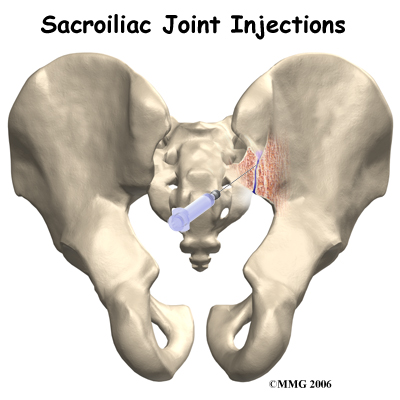
Sacroiliac (SI) joint injections are primarily diagnostic injections, meaning that they help your health care professional delineate the cause of your back pain. They may also be used to give temporary pain relief if you suffer from chronic SI joint pain but the injections do not usually eliminate the pain and they may not provide prolonged pain relief. These injections temporarily assist the pain by filling the SI joint with an anesthetic medication that numbs the joint, the ligaments, and the joint capsule around the SI joint. In some cases, eliminating the pain even for a short while can help you to move more easily which allows you to rehabilitate your low back and sacral area and decrease your symptoms long term.
This guide will help you understand:
- where the injection is given
- what your doctor hopes to achieve
- what you need to do to prepare
- what you can expect from the injection
- what might go wrong
- what Sport And Spine Physiotherapy’s approach to rehabilitation is
#testimonialslist|kind:all|display:slider|orderby:type|filter_utags_names:Back Pain|limit:15|heading:Hear from some of our patients who we treated for *Back Pain*# Anatomy
What parts of the body are involved?
The SI joint connects the sacrum and the iliac bones. You can often see the location of these joints on the surface of the skin as two small dimples on either side of the lower back at the belt line. The sacrum is a triangular-shaped bone formed by the fusion of several vertebrae during development. It sits at the lower end of the spine, just below the lumbar spine.
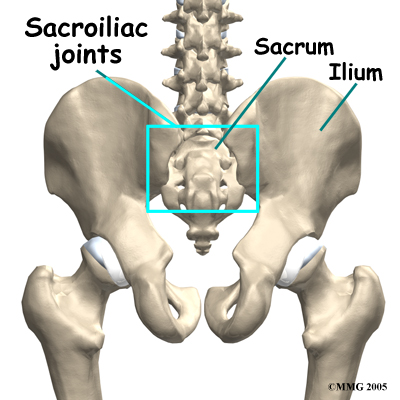
The SI joint is one of the larger joints in the body. The surface of the joint is wavy and fits together similar to the way two gears fit together. Very little motion occurs in the SI joint. The motion that does occur is a combination of sliding, tilting and rotation. The most the joint moves in regards to sliding is probably only a couple of millimeters, and it may tilt and rotate two or three degrees.
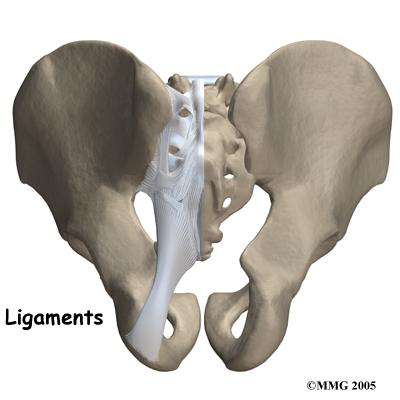
Several large, very strong ligaments hold the SI joint together. The strongest ligaments are in the back of the joint outside of the pelvis. The pelvis is a ring shape so these ligaments work somewhat like the hoops that hold a barrel together. The joint shape and the ligaments are one component in keeping the joint stable; the other component is the force of the muscles. If the ligaments are torn, the pelvis can become unstable. This sometimes happens when a fracture of the pelvis occurs and the ligaments are concurrently damaged. In most cases of injury to the SI joint, however, the ligaments are not completely torn, as they are very strong. If there is a great amount of force is involved however, such as in motor vehicle accidents, the ligaments can be badly injured.
As stated above the SI joint does not move a large amount in adults, but during pregnancy this can change. During the end of pregnancy, as delivery nears, the hormones that are produced cause the SI joint to relax. This relaxation of the ligaments allows the pelvis to be more flexible so that birthing can occur more easily. Multiple pregnancies, which increase the amount of overall time that the joint is acting in a more flexible way, seem to increase the amount of arthritis that forms in the joint later in life. It should be highlighted again that in comparison to other joints in the body, such as the shoulders or hips, ‘excess’ movements in the SI joints are still relatively very small and are difficult or impossible for you to feel yourself.
It appears that the primary function of the SI joint is to be a shock absorber, and to provide just enough motion and flexibility to lessen the stress on the pelvis, trunk, and spine. In addition, the motion at the SI joint functions in harmony with the biomechanical motion in the lower extremities during activities such as walking and running in order to transfer the impact load and to lessen the overall stress received by the body during these activities.
The older one gets, the more likely that the joint is completely immobile, or ankylosed. Ankylosis is a term that means a joint has become completely stiffened with no movement at all.
Related Document: Sport And Spine Physiotherapy's Guide to Lumbar Spine Anatomy
Rationale
What does my doctor hope to achieve?
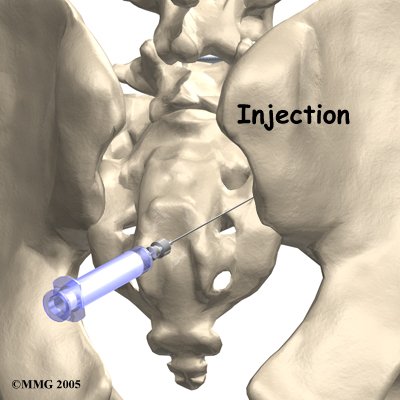 Your doctor is generally recommending a SI joint injection to try and determine if one, or both, SI joints are the cause of your back pain. This type of injection is primarily a diagnostic injection but may assist with pain temporarily, sometimes just for a few hours, but it can be longer. Once your doctor is sure that it is the SI joint causing your pain, other procedures may be recommended to reduce your pain for a longer period of time. An SI joint injection cannot be done while you are pregnant but may be done if your pain does not go away after delivery or becomes chronic due to multiple pregnancies. Your doctor is generally recommending a SI joint injection to try and determine if one, or both, SI joints are the cause of your back pain. This type of injection is primarily a diagnostic injection but may assist with pain temporarily, sometimes just for a few hours, but it can be longer. Once your doctor is sure that it is the SI joint causing your pain, other procedures may be recommended to reduce your pain for a longer period of time. An SI joint injection cannot be done while you are pregnant but may be done if your pain does not go away after delivery or becomes chronic due to multiple pregnancies.
During a SI joint injection, the medications that are normally injected include a local anesthetic and cortisone. The anesthetic medication, such as lidocaine or bupivicaine, is the same medication used to numb an area when you are having dental work or having a laceration sutured. These medications cause temporary numbness lasting one to six hours, depending on which type of anesthetic is used.
Cortisone is an extremely powerful anti-inflammatory medication. When this medication is injected into a painful, inflamed joint, it can reduce the inflammation and swelling. Reducing the inflammation can reduce pain. If cortisone is also injected into the joint, you may get several weeks' worth of relief from your pain. This can allow you to get started or continue in a physiotherapy program, strengthen the muscles, and begin normal movement again. When the cortisone wears off, the pain may or may not return.
Related Document: Sport And Spine Physiotherapy's Guide to Sacroiliac Joint Dysfunction Preparations
How will I prepare for the procedure?
To prepare for the procedure your doctor may tell you to remain "NPO" for a certain amount of time before the procedure. This term means that you should not eat or drink anything for the specified amount of time before your procedure. This includes avoiding water, coffee, tea etc. Nothing should be ingested. You doctor may give you special instructions, however, to take some or all of your usual medications with a small amount of water.
In some cases you may be instructed to discontinue certain medications that affect the clotting of your blood several days before the injection. By ceasing these medications for this amount of time it reduces the risk of excessive bleeding during and after the injection. These medications may include the common Non-Steroidal Anti-Inflammatory Drugs (NSAIDs) such as aspirin, ibuprofen, naproxen and many other medications that are commonly used to treat arthritis. If you are taking any type of blood thinning medication you should let your doctor know. Your doctor will need to determine if it is safe to discontinue these medications in order to have the injection. Most often you will need to have these types of medications regulated or temporarily discontinued prior to an SI injection.
You may need to arrange to have transportation both to and from the location where you will undergo the injection. Wear loose fitting clothing that is easy to take off and put on. You may wish to take a shower the morning of the procedure using a bactericidal soap to reduce chances of infection. Do not wear jewelry or any type of scented oils or lotions.
Procedure
What happens during the procedure?
When you are ready to have the injection, you will be taken into the procedure area and an IV will be started. The IV allows the nurse or doctor to give you any medications that may be needed during the procedure. The IV is mainly for safety reasons as it allows a very rapid response to be carried out by the health care team if you have a problem during the procedure, such as an allergic reaction to any of the medications injected. In addition, if you are in pain or are very anxious, you may also be given medications through the IV for sedation during the procedure.
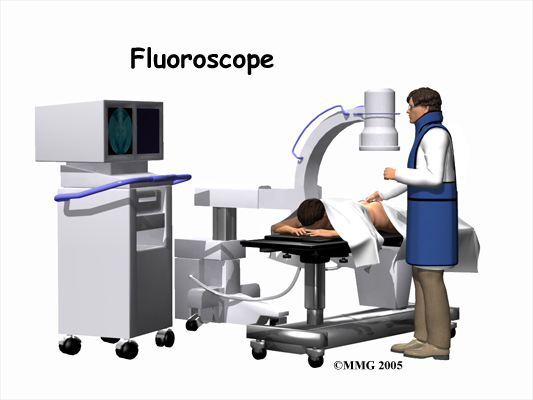 SI joint injections are done with the help of fluoroscopic guidance. The fluoroscope is an x-ray machine that allows the doctor to see a real-time x-ray image of the area while doing the procedure. This allows the doctor to watch where the needle goes as it is inserted which makes the injection much safer and more accurate. Once the needle is in the right location, a small amount of radiographic dye is injected. This liquid dye shows up on the x-ray image and the doctor can see where it goes. The medication used for the injection will go in the same place, so the doctor wants to make sure that the medication will go to the right place to get the most benefit. Once the correct position is confirmed, the medication is injected and the needle is removed. SI joint injections are done with the help of fluoroscopic guidance. The fluoroscope is an x-ray machine that allows the doctor to see a real-time x-ray image of the area while doing the procedure. This allows the doctor to watch where the needle goes as it is inserted which makes the injection much safer and more accurate. Once the needle is in the right location, a small amount of radiographic dye is injected. This liquid dye shows up on the x-ray image and the doctor can see where it goes. The medication used for the injection will go in the same place, so the doctor wants to make sure that the medication will go to the right place to get the most benefit. Once the correct position is confirmed, the medication is injected and the needle is removed.
When the procedure is complete you will be taken out of the procedure room to the recovery area. You will remain in the recovery area until the nurse is sure that you are stable and that have not had any allergic reaction to the medications. The anesthetic may cause some temporary numbness and weakness. You will be free to go home once these symptoms have resolved.
Complications
What might go wrong?
Injection procedures are safe and unlikely to result in a complication, but no procedure is 100% foolproof. There are several complications that may occur during or after the SI joint injection. This document doesn't provide a complete list of the possible complications, but it does highlight some of the most common problems. As indicated, complications are uncommon, but you should know what to watch for if they occur.
Allergic Reaction
Like most procedures where medications are injected, there is always a risk of allergic reaction. The medications that are commonly injected include lidocaine, bupivicaine, radiographic dye, and cortisone. You should alert your doctor if you have known allergies to any of these medications. Allergic reactions can be as simple as developing hives or a rash but a reaction can also be life threatening and restrict breathing. Most allergic reactions will happen right away while you are in the procedure room so help is available immediately. Usually reactions are treated and cause no permanent harm.
Infection
Several types of infections are possible complications of SI joint injections. Any time a needle is inserted through the skin, there is a possibility of infection. Before any injection is done, the skin is cleansed with a disinfectant and the health care provider doing the injection uses what is called a sterile technique. This means that the needle and the area where the needle is inserted remains untouched by anything that is not sterile. The provider may also use sterile gloves.
Infections can occur just underneath the skin, in a muscle, or in the sacroiliac joint. Signs and symptoms of an infection are increasing redness of the area, swelling, pain, and fever. Almost all infections will need to be treated with antibiotics. If an abscess forms, then a surgical procedure may be necessary to drain the pus in the abscess. Antibiotics will also be necessary to treat the infection after an abscess.
Increased Pain
Not all injections work as expected. Sometimes, injections cause more pain. This may be due to increased spasm in the muscles around the injection site. The increased pain is usually temporary, lasting only a few hours or a few days. Once the medication has a chance to work after this initial painful period, the injection may still reduce your pain. Increased pain that begins several days after the injection may be a sign of infection. You should alert your doctor if this occurs.
After Care
What happens after the procedure?
If everything goes as planned, you will be able to go home soon after the injection, probably within one hour. There are no restrictions on diet or activity after the injection. If you have already been doing physiotherapy at Sport And Spine Physiotherapy you should return to therapy as soon as it is feasible. Physiotherapy treatment is beneficial after the injection because the short period of pain relief received from the injection is often enough to allow you to more effectively do your physiotherapy exercises and hopefully more permanently decrease your overall pain levels and improve the way you move. If you have not done any physiotherapy yet for your SI joint pain prior to the injection then you should begin treatment at Sport And Spine Physiotherapy as soon as you can after the injection.
Both your doctor and physiotherapist will be interested in how much the pain is reduced while the anesthetic (numbing medication) is working. You may be given a pain diary to record what you feel for several hours after the injection. This is important for making decisions about treatment, so keep good track of your pain levels. You may find it easiest to grade your pain periodically in the pain diary from zero to ten with zero being no pain at all and ten being the worst pain you have ever felt.
Most doctors will arrange a follow-up appointment or phone consult within one or two weeks of the procedure to see how you are doing and what effect the procedure had on your symptoms.
It is important to remember that a sacroiliac joint injection is usually not a cure for your pain; it is only a part of your overall pain management plan. You will still need to actively continue working with the other recommendations from your physiotherapist and any other health care professional involved in your pain management plan.
Rehabilitation
Physiotherapy at Sport And Spine Physiotherapy can be very useful for patients with SI joint pain both before having an injection as well as after. After having a SI joint injection there may be a short window of period where you have some relief from your discomfort in the area, and this window allows you to rehabilitate your SI joint and improve your overall movements. This may in turn decrease your symptoms long term.
When you visit Sport And Spine Physiotherapy your physiotherapist will assess your SI joint dysfunction and will determine how well the joint is moving. The joint can be moving fairly well, or there can be too much movement (hypermobile) or not enough movement (hypomobile.) Your individual physiotherapy treatment will be determined according to these findings. Knowing whether or not you have received much relief from the SI joint injection will assist your physiotherapist greatly in determining how much of your pain is coming directly from your SI joint. All other areas pertinent to your SI joint, such as your back and hip areas, will also be assessed to determine how much they may also be contributing to your pain.
Generally it is not recommended to treat any pain you have that is directly related to the injection itself for at least a few days. The injection is done specifically to determine how your SI joint reacts to the injected substances, so waiting and watching to see if there is discomfort at first is generally the best approach. If, however, you have ongoing pain from the injection itself that lasts longer than would be expected, or your original pain returns after the injection your physiotherapist will treat this discomfort. They may use heat, ice, or electrical modalities such as ultrasound or interferential current to help decrease your pain. They may also massage around your back, buttocks, and hip areas to provide relief by relaxing tight muscles that could be pulling on the SI joint. In addition, your physiotherapist will ask you to limit or modify those activities, if possible, that irritate your SI pain. A short period of resting from aggravating activities can help to calm an irritated joint.
When movement of a joint is limited, encouraging more motion can ease the pain. If your therapist determines that your SI joint doesn't have full range of motion, your therapist has several methods to assist you in increasing the movement at your SI joint. These methods may include using joint mobilizations or manipulations, performing passive stretching, and massaging any tight muscles related to the area. Stretches and strengthening exercises as part of a home program will also be prescribed as they can help you mobilize your own stiff SI joint, as well as improve the muscles around the joint that help support it. These exercises may be targeted at your SI joint directly, but will also include exercises for your low back, abdominals and core area, buttocks and hips, groin, and the front and back of your thighs. These areas immediately around the SI joint are crucial in supporting the pelvis and the joint itself. Having a stiff low back or stiff hip in particular can significantly increase the stress put through your SI joints, so improving the mobility in these areas will certainly be focused on.
Maintaining a strong abdominal core muscule area is also particularly important in easing the discomfort that comes from SI joint pain, so exercises for this area will also be focused on. Even just simple exercises such as tightening the muscles of your deep abdominal area directly after your SI joint injection will help to support the area. These exercises are important whether your joint is not moving well or is moving too much. Your physiotherapist can teach you how to properly activate these muscles. As you improve your activation of these muscles, more advanced exercises will be prescribed in order to challenge the ability of these muscles to control the motion of the joint.
If your SI joint is deemed to have too much relative mobility your physiotherapy treatment will be aimed at helping to stabilize the SI joint. Specific strengthening exercises will be taught in order to improve strength in muscles that support the SI joint such as certain muscles of the low back, the abdominal and core area as described above, the groin, and the deep and superficial buttocks muscles. Developing muscular endurance in these areas is just as important as developing strength. The SI joint is put under stress during nearly every activity that you undertake, even sitting or rolling in bed, so the ability to support the joint’s alignment for long periods of time is crucial. Any deviation from correct biomechanics even for short periods can potentially put stress on the SI joint and cause discomfort, particularly if the joint is already irritable. Specific stretching exercises will also be prescribed in order to ease off the aberrant pull of tight muscles around the joint.
Unfortunately, few muscles actually connect to both the sacrum and the pelvis and therefore although you strengthen the weak muscles, stabilizing the SI joint completely can be more difficult in comparison to stabilizing other joints. Your SI joint may continue to move relatively more than normal and cause you ongoing discomfort with certain activities or when your muscles get tired. To combat this overall increased motion and to aid in proper alignment your therapist may suggest that you use a SI belt to help stabilize the joint. An SI belt is worn over the SI joints and around the hip area to help compress the joint together in order to create increased stability. Wearing an SI belt can often ease pain during activity and allow you to exercise comfortably. Many pregnant women find these belts particularly helpful. Using tape on the SI joint area, hips, and low back can also help to ease some of your pain, so your therapist may try doing this either before suggesting a belt, or in conjunction with doing so.
As with any injury or biomechanical dysfunction, maintaining one’s posture and alignment is very important. Despite whether your therapist determines that your SI joint has increased or decreased motion, they will be strict in encouraging you to maintain proper posture and alignment at all times. Maintaining good posture can significantly decrease the stress put through the SI joints. Any window of time that you have which is pain-free after your SI injection can be particularly useful in re-training your body to maintain proper alignment. By improving the endurance of the muscles that support the SI joint, you will be able to maintain your posture and alignment for longer periods of time, and lengthen the time frame between painful bouts of SI joint irritation.
Generally the treatment we provide at Sport And Spine Physiotherapy for SI joint pain after an injection can assist greatly in managing this injury. Sometimes, however, SI joint pain does not improve as much as we would expect after an injection and with the treatment we provide at Sport And Spine Physiotherapy. If this is the case, your therapist may suggest you return to your doctor to discuss other pain relief options which may include another injection to the area.
Portions of this document copyright MMG, LLC.
Sport And Spine Physiotherapy provides services for physiotherapy in Sarnia.
|
|
|
Thank you for being so professional and genuinely caring!
– J S
I appreciate the thoroughness of this clinic. When I come here I feel my concerns are being heard and treated accordingly..
– B M
Attentive, right on top of everything!.
– S M
I will not hesitate to return or refer friends and family..
– D P
Thanks SO much for all of your help and dedication! Your commitment is so appreciated.
– C L
Thanks a million for helping me. I am gracious for your compassion and extraordinary professionalism.
– M T
My recovery and my confidence in my knee is all thanks to you. I couldn’t have done it without Sport And Spine.
– B S
The team works like a well oiled machine, from start to finish. I’m truly grateful!
– J B
|
 |
 |
|
|
|
|
|
|


















 Your doctor is generally recommending a SI joint injection to try and determine if one, or both, SI joints are the cause of your back pain. This type of injection is primarily a diagnostic injection but may assist with pain temporarily, sometimes just for a few hours, but it can be longer. Once your doctor is sure that it is the SI joint causing your pain, other procedures may be recommended to reduce your pain for a longer period of time. An SI joint injection cannot be done while you are pregnant but may be done if your pain does not go away after delivery or becomes chronic due to multiple pregnancies.
Your doctor is generally recommending a SI joint injection to try and determine if one, or both, SI joints are the cause of your back pain. This type of injection is primarily a diagnostic injection but may assist with pain temporarily, sometimes just for a few hours, but it can be longer. Once your doctor is sure that it is the SI joint causing your pain, other procedures may be recommended to reduce your pain for a longer period of time. An SI joint injection cannot be done while you are pregnant but may be done if your pain does not go away after delivery or becomes chronic due to multiple pregnancies. SI joint injections are done with the help of fluoroscopic guidance. The fluoroscope is an x-ray machine that allows the doctor to see a real-time x-ray image of the area while doing the procedure. This allows the doctor to watch where the needle goes as it is inserted which makes the injection much safer and more accurate. Once the needle is in the right location, a small amount of radiographic dye is injected. This liquid dye shows up on the x-ray image and the doctor can see where it goes. The medication used for the injection will go in the same place, so the doctor wants to make sure that the medication will go to the right place to get the most benefit. Once the correct position is confirmed, the medication is injected and the needle is removed.
SI joint injections are done with the help of fluoroscopic guidance. The fluoroscope is an x-ray machine that allows the doctor to see a real-time x-ray image of the area while doing the procedure. This allows the doctor to watch where the needle goes as it is inserted which makes the injection much safer and more accurate. Once the needle is in the right location, a small amount of radiographic dye is injected. This liquid dye shows up on the x-ray image and the doctor can see where it goes. The medication used for the injection will go in the same place, so the doctor wants to make sure that the medication will go to the right place to get the most benefit. Once the correct position is confirmed, the medication is injected and the needle is removed.



